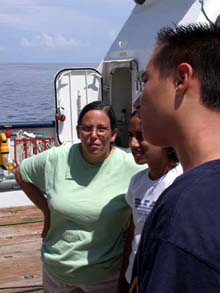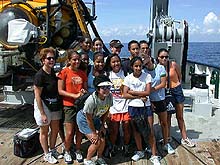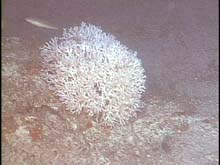
Oculina coral is brilliant white when seen beneath the surface. In dense stands it creates a community of natural beauty that nurtures a great abundance of life that strikes a chord of wonder and discovery in many of us. Click image for larger view.
Oculina Bank from a Teacher's Perspective
September 5, 2001
Jody Berman, Educator-at-sea
Biological Scientist
Museum of Discovery and Science
Fort Lauderdale, Florida
![]() View a video of a three-dimensional "fly-though" of Chapman's Reef. (2.4 Mb, QuickTime
View a video of a three-dimensional "fly-though" of Chapman's Reef. (2.4 Mb, QuickTime ![]() required.)
required.)
As an educator at the Museum of Discovery and Science in Fort Lauderdale, FL, I have the unique challenge of finding ways to both entertain and educate the public. The key to success in these efforts has been either finding a way to make people see the connection between their everyday lives and the natural world that surrounds them, or generating a sense of discovery or wonder about the organisms with whom we share our planet. While the latter can be effective for some, I believe that the former makes a more lasting impression on most people, especially when framed in a way that they see that each individual can make a difference.
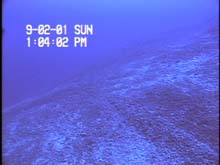
This image clearly shows the likely impact of bottom trawling on Oculina Banks. Note the linear feature at the lower right. On this type of bottom, small linear mounds of coral rubble are created immediately adjacent to the track of the trawl. Click image for larger view.
A Complex System
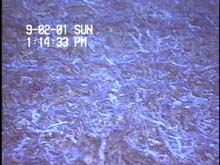
Oculina coral rubble. Oculina Banks is replete with coral in this condition. Click image for larger view.
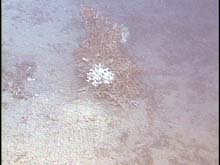
An intact dead Oculina coral head. While there may be strong evidence that trawling has reduced significant amounts of Oculina to rubble, questions remain regarding other possible causes of mortality such as in this case where the dead Oculina coral head remains intact. Click image for larger view.
Instead, what I found was that this system, like so many others we seek to protect, is more complex than I had first thought. I saw both of the images I had imagined -- reefs that were luxuriant and teeming with life, and areas in which the coral had been reduced to rubble. I also saw areas covered by intact dead coral, however. While the first two fit my pre-conceived notion, the third did not. In addition, while direct evidence of human impacts on the system (trawl marks, fishing line, anchor weights) was observed in many of the rubble areas, in others, we could see no evidence of direct human impacts. Therefore, while scientists on board have compelling evidence that fishing has caused harm to much of the reef, questions remain as to what other factors (either environmental or human-induced) might also be causing the corals to die.
So, I am forced to rethink my first impressions, and find myself reviewing all I have learned about the ecosystem and the problems it is facing. I know that the scientists who discovered the reefs on Oculina Bank in the 1970s described them as luxuriant and healthy ecosystems that covered many miles of substrate off Florida's east coast. The scientists also documented that the reefs supported many different types of organisms and were the spawning grounds of many commercially important species of fish, particularly groupers. These were among the attributes that led to the designation of this region as a marine protected area. Based upon the videos taken on this mission and by my visiting the ecosystem firsthand, however, it is my impression that these areas of rich and luxuriant reefs are less common than they once were. Perhaps simply designating the area as protected is not enough to assure its long term survival; either destructive human activities continue to occur even within the protected areas, causing the damage we observed, or other environmental factors (human or natural) are also causing the reefs to decline.
Education Based on Questions Thus, rather than building an educational program based on answers, I will need to build one based on questions. I must find a way to tell people what the scientists do know, and ask my students and the public at large two sets of questions. The first set would focus on how scientists can best go about proving that human activities in general, and fishing in particular, are causing the decline of these areas even as they are supposed to be protected. The second set would focus on how to translate that scientific knowledge into action that can protect the system and the creatures that depend on it. Taken together, these sets of questions will not only raise public awareness of the issues, but will also provide new understanding of the fragile and valuable resource, along with tangible ways to help protect it.
At the end of my voyage, I am hopeful that this mission, and the ones that follow, will allow scientists to move closer to answering some of the questions we have before us today. I know that I will keep challenging people to think about the system and to ask questions. I say this because I would like to believe that if people understood these ecosystems, then we would not have to worry about whether these reefs, and the creature that depend on them, will be here for generations to come. After all, I can't think of a better ending to my story than to bring my children here in the future and see the ecosystem healthy again.
(top)
On Wednesday, September 5, 11 students from A.D. Henderson University School in Boca Raton, FL, two of their teachers, and Claire Johnson, education coordinator for the National Marine Sanctuaries Program, rendez-voused with the Seward Johnson II on Chapman's Reef, about 15 mi off Florida's east coast. They came on three small boats under warm, bright blue skies and gentle seas. The students observed many of the science activities aboard the ship that day, including ROV operations and submersible dives. They discussed the resource management and restoration issues of Oculina Bank with mission scientists, and climbed inside the Clelia submersible as it rested on the deck of its mother ship. Following are their impressions on a number of different facets of the Islands in the Stream South Atlantic Bight Mission leg to Oculina Bank.
Students
Alex, Blessing, Cealan, Chelsea, Diana, Florian, Kendra, Lauren, Rashunda, Trisha, Vanessa
EducatorsMuriel, Sandra, Claire Johnson
(top)
 Alex
AlexStudent-at-sea
Data
On this mission, the scientists are collecting five types of data, all of which are useful. Two types of videotapes are being collected: the low-light, gray-scale and the regular color video. Another type of data comes from the CTD, which is mounted to the sub. The CTD measures,
and stands for, conductivity, temperature, and depth. Samples from the bottom are also collected. These include soil as well as coral and other animals. Water depth is also measured using a fathometer. These data are used to plot courses and make maps of the study area. Finally, annotations are made of the videos. These are used to learn more about the habitat and make fish counts. Scientists study all of the data collected by the submersible and other machines to learn more about the ocean and help protect the environment.
(top)
 Blessing
BlessingStudent-at-sea
ROV (Remotely Operated Vehicle)
On this trip I learned that an ROV is a mechanical craft that is used to go underwater to collect samples or data from places, such as space and the sea, that can be very hostile or inaccessible to people. The ROV on this ship was launched today at noon and resurfaced at around 1:30 pm. It is operated "remotely" by a person on board the ship. We were able to observe all of the operations.
On this ship, the ROV is being used to study the different kinds of habitats in the area and to study the different types of sea life in each. Some of the jobs that the ROV does are to film the marine life, collect samples from the ocean floor, and explore things and
places that people have never seen before. Without ROVs, there are many things that we wouldn't know about what is under the sea and out of our reach. ROVs are a good example of the way technology is used in our world.
(top)
 Cealan
CealanStudent-at-sea
The Clelia Submersible
The Clelia, a 2- to 3-man submarine, is very small. It is 9 ft 7 in high, 23 ft long, and weighs 10 tons. The purpose of this particular submarine is to study the bottom of the ocean. It can travel to a depth of 1,000 ft below the surface.
Perry Oceanographics built the submarine in 1976 to inspect oil platforms and well-heads. In 1992, the Harbor Branch Oceanographic Institute (HBOI) bought the sub and refurbished it to make it suitable for researching and observing underwater. The sub's battery lasts 4-5 hrs, and if the battery ran out, the captain and two passengers would have enough clean air to live for up to 120 hrs without returning to the surface.
I watched the crew of the Seward Johnson II deploy the Clelia. Two hrs later, I watched them bring the submarine back up on the ship. When the divers came out, they brought with them samples of coral and other animals, such as colorful sea stars, that they had collected. On this mission, the scientists are collecting 5 types of data, all of which are useful. Two types of videotapes are being collected: the low-light, gray-scale and the regular color video. Another type of data comes from the CTD, which is mounted to the sub. The CTD measures, and stands for, conductivity, temperature, and depth. Samples from the bottom are also collected.
(top)
 Chelsea
ChelseaStudent-at-sea
Animals of Oculina Bank and Their Adaptations
In an area 18 mi out to sea, with most of the reef destroyed, you don't find the same animals as you did 20 yrs ago. Today, if you put an ROV in the water approximately 280 ft down, you would not see all of the fish, sea stars, brittle stars, sea cucumbers and corals that you once saw. Today, you may see grouper, dolphins and sharks, but not in the same numbers as they used to see. These organisms need protection to survive from larger sea creatures and from humans. Hopefully, these reefs will grow back, and you will once again see large numbers of animals.
I think that in these reefs off the coast of Fort Pierce, Florida, the major thing that the fish need to adapt to is temperature change. If the water temperature drops too low and gets too cold, then the fish may go into a stage of sleep. While in this stage, they become an easy meal for a larger fish. This is why the reef is so important. It gives protection and also supplies food. Because two-thirds of the reef has been destroyed, the fish have no place to hide and less food to eat, so most of the fish have disappeared.
(top)
 Diana
DianaStudent-at-sea
Spending Time at Sea
Going on this vessel was one of the most interesting projects I have participated in. I learned so many facts and ideas and met a lot of fascinating scientists and engineers. The research taking place on this ship was about the Oculina coral reefs off the coast of Florida. The site that we visited was once densely covered with this ivory tree coral, which is as fragile as china and is very slow-growing. Scientists estimate that commercial fishing has destroyed two-thirds of this rare coral species.
I had a great time and this was a wonderful learning experience. I would definitely spend 10 days aboard this ship. I could learn so much more in different fields if I was here that long. The study is so extensive that we only saw brief parts in our one day at sea.
(top)
 Florian
FlorianStudent-at-sea
Groupers
Groupers are hermaphroditic deep-sea fish. Groupers are all born as females. One or two of the females develop into males, and the dominant male stays with the harem of females, while the other male leaves the area. Each male has its own territory on the reef. When fishermen come out and fish in their territories, they usually catch the males, as they are more aggressive and more likely to take the bait. This affects the whole grouper population. If all of the males are gone, then one of the females needs to change into a male. This process takes about a year. This means that the groupers will miss one whole reproductive year, causing a drop in the number of groupers in the area.
(top)
 Kendra
KendraStudent-at-sea
Fish Sounds and Hydrophones
Fish sounds are some of the sounds that hydrophones (underwater microphones) pick up. They are the sounds that the different fish make while in the water, usually when they are spawning. The hydrophones are left in the water (with recording devices) for days or sometimes weeks at a time. They are then picked up and the recordings are studied.
The recordings are important because different agencies test the equipment to develop better models and prototypes. These models may progress in accuracy until scientists can identify fish just by listening to the sounds recorded by the hydrophone. This technology will make it easier to identify fish species and study populations of fish, as scientists will be able to determine what fish reside in an area and when, even if they weren't there to see them.
(top)
 Lauren
LaurenStudent-at-sea
Habitat Protection
There aren't many coral reefs left in the world. Without coral reefs, many of the fish would die, because they would have nowhere to grow up and no place to find food. There would be fewer fish in the ocean, and some species might even go extinct. When one species of fish dies, a domino effect often occurs, because of all the interrelationships among species.
Seafood is one of the most important sources of food on Earth, as it feeds both animals and humans. Coral reefs are also being studied for medicines, and if we protect them today, then scientists in the future may be able to find cures for diseases like cancer. The coral reefs take a long time to grow back, and they are very fragile. Coral reefs are also large tourist attractions, and we need to educate the public concerning the dangers that reefs face and why we need to protect them.
(top)
 Rashunda
RashundaStudent-at-sea
The Clelia Submersible
Today, on the Harbor Branch Oceanographic Institution research vessel Seward Johnson II, we learned a great deal of information. One station that I learned the most from and enjoyed was the Clelia submersible. After meeting the pilot of the sub, Don Liberatore, we were informed about the duties and operations of the submersible. The Clelia is 23 ft long, 8 ft 3 in wide, and 9 ft 7 in high. It can dive to a maximum depth of 1,000 ft, travelling at a speed of 3 knots. The sub can accommodate three people (one pilot and two observers), and a dive can last for four to five hrs. Scientists use the Clelia to make observations, collect organisms, take core samples, search for and recover objects, survey the sea bottom, and perform impact studies.
The Clelia is lowered from the deck of the Seward Johnson II, which is equipped with an A-frame crane on the stern. The A-frame operator lifts the sub from deck and places it into the water so that it can perform its duties. I learned a great deal of information about the Clelia today and enjoyed being on board.
(top)
 Trisha
TrishaStudent-at-sea
Ocean Explorer Web Site
The Web site for this project is www.oceanexplorer.noaa.gov. This site contains mission logs of all the explorations, education information, research summaries, and new discoveries. For this mission, pictures of the reefs and other sea organisms observed from the ROV and the submersible Clelia are posted daily. The purpose of the Web page is to educate the public about the wonders of the sea and the destruction of the fisheries and habitat of the Oculina Research Reserve. In the future, I would like them to add to the Web site day-to-day entries of each of the crew members' experiences. Beside each entry, I would also like to see a job description or a pictures of the crew member who wrote the entry.
(top)
 Vanessa
VanessaStudent-at-sea
What Should Scientists Study Next in This Area?
I think that scientists should continue their study of the groupers and whether the numbers of males in the population has increased. Hermaphrodites are an interesting topic, and deeply influence the population of groupers in the Reserve. Learning about the different color patterns on grouper scales was also an interesting topic. I had no idea that their colors changed as they got older and matured!
In addition to studying groupers, scientists should examine the progress on the recovery of the coral reefs. By using ROVs (remotely operated vehicles) and submersibles such as the Clelia, they can explore unknown areas. By doing this, scientists will learn more about the geography and topography of these deep-water areas. They will also learn more about Oculina coral, a rare species that grows only in limited areas.
The scientists are attempting to discover why the coral here was destroyed and what caused the destruction; they should continue this work. Scientists should also continue to check the growth of the coral on the reef balls that were placed throughout the area. The balls weith 400 lbs each and are made of a special cement that has a low pH. Recently, 105 of them were placed on the ocean floor in hopes of "jump starting" the growth of the coral reef and giving the small animals that live on the reef a place to hide from predators.
(top)
Visiting the Seward Johnson II on its mission to the Oculina Research Reserve has been one of the most fascinating experiences in my career. This was not only a great learning experience for my students, but also for me. It is one thing to teach students about science, research, and technology from a textbook, and another to allow them to experience firsthand, and learn from experts about, the use and applications of new and available technology.
The students also learned about the education and requirements needed for diverse types of jobs available in research, and were highly impressed by the interest that the on-board professionals showed toward them. Personally, the expedition has sparked the curiosity and quest for knowledge that I felt as a young college student. It is my hope that others have an opportunity to participate in an activity of this type and are touched in such a positive way. My students and I will share our experience with others and invite them to participate by following the mission on-line, and by becoming involved in environmental service in the community.
(top)
 Sandra
Sandra
Director
A.D. Henderson University School
 Claire Johnson
Claire Johnson
Education Coordinator
National Marine Sanctuary Program
Sign up for the Ocean Explorer E-mail Update List.












































